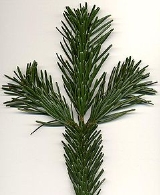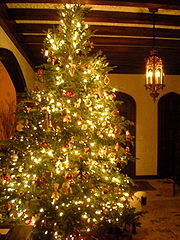
Nordmann Fir
Encyclopedia
Nordmann Fir is a fir
native to the mountain
s south and east of the Black Sea
, in Turkey
, Georgia
, Russia
n Caucasus
and northern parts of Armenia
. It occurs at altitudes of 900-2,200 m on mountains with a rainfall of over 1,000 mm.
It is a large evergreen
coniferous tree
growing to 60 m tall and with a trunk diameter of up to 2 m. In the Western Caucasus
Reserve, some specimens have been reported to be 78 m and even 85 m tall, the tallest trees in Europe.
The leaves
are needle-like, flattened, 1.8-3.5 cm long and 2 mm wide by 0.5 mm thick, glossy dark green above, and with two blue-white bands of stomata below. The tip of the leaf is usually blunt, often slightly notched at the tip, but can be pointed, particularly on strong-growing shoots on young trees. The cones
are 10-20 cm long and 4-5 cm broad, with about 150-200 scales, each scale with an exserted bract and two winged seed
s; they disintegrate when mature to release the seeds.
There are two subspecies (treated as distinct species by some botanists), intergrading where they meet in northern Turkey
at about 36°E longitude:
The species is named after Finnish
zoologist Alexander von Nordmann
(1803-1866), Professor of Botany at Odessa
.
 Nordmann Fir is one of the most important species grown for Christmas tree
Nordmann Fir is one of the most important species grown for Christmas tree
s, being favoured for its attractive foliage, with needles that are not sharp, and do not drop readily when the tree dries out.
It is also a popular ornamental tree in park
s and large garden
s.
The wood
is soft and white, and is used for general construction, paper
, etc.
Fir
Firs are a genus of 48–55 species of evergreen conifers in the family Pinaceae. They are found through much of North and Central America, Europe, Asia, and North Africa, occurring in mountains over most of the range...
native to the mountain
Mountain
Image:Himalaya_annotated.jpg|thumb|right|The Himalayan mountain range with Mount Everestrect 58 14 160 49 Chomo Lonzorect 200 28 335 52 Makalurect 378 24 566 45 Mount Everestrect 188 581 920 656 Tibetan Plateaurect 250 406 340 427 Rong River...
s south and east of the Black Sea
Black Sea
The Black Sea is bounded by Europe, Anatolia and the Caucasus and is ultimately connected to the Atlantic Ocean via the Mediterranean and the Aegean seas and various straits. The Bosphorus strait connects it to the Sea of Marmara, and the strait of the Dardanelles connects that sea to the Aegean...
, in Turkey
Turkey
Turkey , known officially as the Republic of Turkey , is a Eurasian country located in Western Asia and in East Thrace in Southeastern Europe...
, Georgia
Georgia (country)
Georgia is a sovereign state in the Caucasus region of Eurasia. Located at the crossroads of Western Asia and Eastern Europe, it is bounded to the west by the Black Sea, to the north by Russia, to the southwest by Turkey, to the south by Armenia, and to the southeast by Azerbaijan. The capital of...
, Russia
Russia
Russia or , officially known as both Russia and the Russian Federation , is a country in northern Eurasia. It is a federal semi-presidential republic, comprising 83 federal subjects...
n Caucasus
Caucasus
The Caucasus, also Caucas or Caucasia , is a geopolitical region at the border of Europe and Asia, and situated between the Black and the Caspian sea...
and northern parts of Armenia
Armenia
Armenia , officially the Republic of Armenia , is a landlocked mountainous country in the Caucasus region of Eurasia...
. It occurs at altitudes of 900-2,200 m on mountains with a rainfall of over 1,000 mm.
It is a large evergreen
Evergreen
In botany, an evergreen plant is a plant that has leaves in all seasons. This contrasts with deciduous plants, which completely lose their foliage during the winter or dry season.There are many different kinds of evergreen plants, both trees and shrubs...
coniferous tree
Tree
A tree is a perennial woody plant. It is most often defined as a woody plant that has many secondary branches supported clear of the ground on a single main stem or trunk with clear apical dominance. A minimum height specification at maturity is cited by some authors, varying from 3 m to...
growing to 60 m tall and with a trunk diameter of up to 2 m. In the Western Caucasus
Western Caucasus
The Western Caucasus is a western region of the Caucasus in Southern Russia, extending from the Black Sea to Mount Elbrus.-World Heritage Site:...
Reserve, some specimens have been reported to be 78 m and even 85 m tall, the tallest trees in Europe.
The leaves
Leaf
A leaf is an organ of a vascular plant, as defined in botanical terms, and in particular in plant morphology. Foliage is a mass noun that refers to leaves as a feature of plants....
are needle-like, flattened, 1.8-3.5 cm long and 2 mm wide by 0.5 mm thick, glossy dark green above, and with two blue-white bands of stomata below. The tip of the leaf is usually blunt, often slightly notched at the tip, but can be pointed, particularly on strong-growing shoots on young trees. The cones
Conifer cone
A cone is an organ on plants in the division Pinophyta that contains the reproductive structures. The familiar woody cone is the female cone, which produces seeds. The male cones, which produce pollen, are usually herbaceous and much less conspicuous even at full maturity...
are 10-20 cm long and 4-5 cm broad, with about 150-200 scales, each scale with an exserted bract and two winged seed
Seed
A seed is a small embryonic plant enclosed in a covering called the seed coat, usually with some stored food. It is the product of the ripened ovule of gymnosperm and angiosperm plants which occurs after fertilization and some growth within the mother plant...
s; they disintegrate when mature to release the seeds.
There are two subspecies (treated as distinct species by some botanists), intergrading where they meet in northern Turkey
Turkey
Turkey , known officially as the Republic of Turkey , is a Eurasian country located in Western Asia and in East Thrace in Southeastern Europe...
at about 36°E longitude:
- Caucasian Fir Abies nordmanniana subsp. nordmanniana. Native to the Caucasus mountains and northeastern Turkey west to about 36°E. Shoots often pubescent (hairy).
- Turkish Fir Abies nordmanniana subsp. equi-trojani (syn. A. bornmuelleriana, A. equi-trojani). Native to northwestern Turkey from Mount IdaMount IdaIn Greek mythology, two sacred mountains are called Mount Ida, the "Mountain of the Goddess": Mount Ida in Crete; and Mount Ida in the ancient Troad region of western Anatolia which was also known as the Phrygian Ida in classical antiquity and is the mountain that is mentioned in the Iliad of...
eastwards to about 36°E. Shoots usually glabrous (hairless).
The species is named after Finnish
Finland
Finland , officially the Republic of Finland, is a Nordic country situated in the Fennoscandian region of Northern Europe. It is bordered by Sweden in the west, Norway in the north and Russia in the east, while Estonia lies to its south across the Gulf of Finland.Around 5.4 million people reside...
zoologist Alexander von Nordmann
Alexander von Nordmann
Alexander Davidovič von Nordmann was a Finnish biologist.-Biography:Alexander von Nordmann was born in Ruotensalmi on May 24, 1803. Nordmann was a professor at Odessa, and collected natural history specimens in southern Russia. He became professor of Zoology at the university of Helsinki in 1849...
(1803-1866), Professor of Botany at Odessa
Odessa
Odessa or Odesa is the administrative center of the Odessa Oblast located in southern Ukraine. The city is a major seaport located on the northwest shore of the Black Sea and the fourth largest city in Ukraine with a population of 1,029,000 .The predecessor of Odessa, a small Tatar settlement,...
.
Uses

Christmas tree
The Christmas tree is a decorated evergreen coniferous tree, real or artificial, and a tradition associated with the celebration of Christmas. The tradition of decorating an evergreen tree at Christmas started in Livonia and Germany in the 16th century...
s, being favoured for its attractive foliage, with needles that are not sharp, and do not drop readily when the tree dries out.
It is also a popular ornamental tree in park
Park
A park is a protected area, in its natural or semi-natural state, or planted, and set aside for human recreation and enjoyment, or for the protection of wildlife or natural habitats. It may consist of rocks, soil, water, flora and fauna and grass areas. Many parks are legally protected by...
s and large garden
Garden
A garden is a planned space, usually outdoors, set aside for the display, cultivation, and enjoyment of plants and other forms of nature. The garden can incorporate both natural and man-made materials. The most common form today is known as a residential garden, but the term garden has...
s.
The wood
Wood
Wood is a hard, fibrous tissue found in many trees. It has been used for hundreds of thousands of years for both fuel and as a construction material. It is an organic material, a natural composite of cellulose fibers embedded in a matrix of lignin which resists compression...
is soft and white, and is used for general construction, paper
Paper
Paper is a thin material mainly used for writing upon, printing upon, drawing or for packaging. It is produced by pressing together moist fibers, typically cellulose pulp derived from wood, rags or grasses, and drying them into flexible sheets....
, etc.

